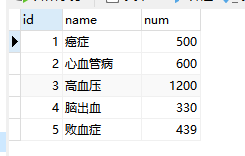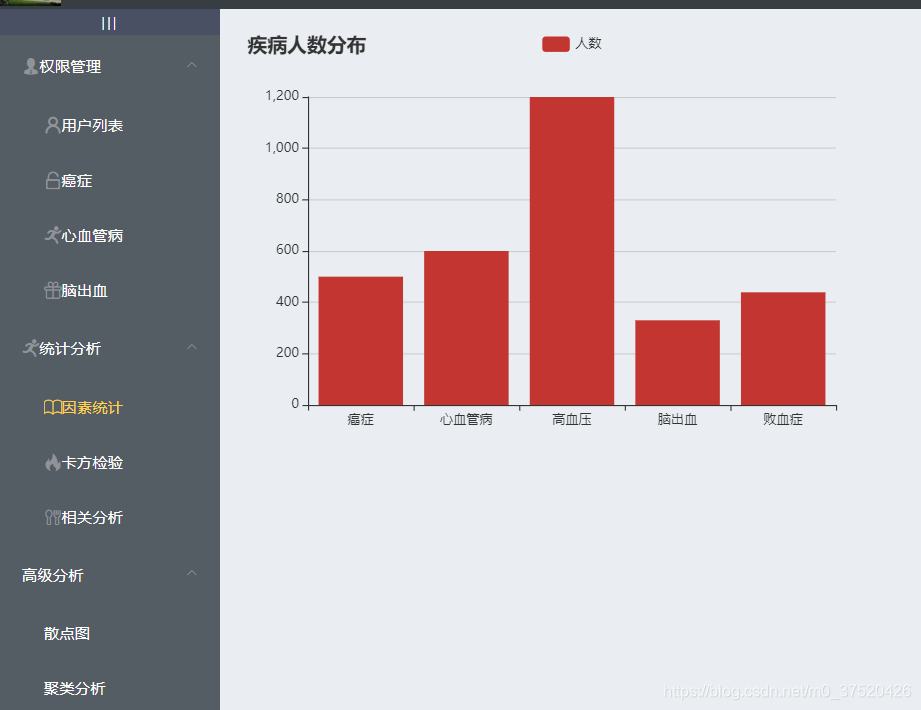热门标签
热门文章
- 1解决vue项目打包后打开index.html一片空白_vue打包后index.html一片空白
- 2cryptapi双向认证_使用CryptoAPI进行数字签名及验证
- 3Linux(Ubuntu):文件系统挂载mount与卸载umount、U盘挂载与卸载、镜像文件挂载与卸载、系统自动挂载_ubuntu mount
- 4如何用monkey测试IOS
- 5Canvas的超基础绘制_canvas.drawcolor
- 62018对口计算机专业,(完整版)2018年河北对口升学计算机专业理论试题(附的答案解析)...
- 7【YOLO小项目】YOLOv5单目测距 pyqt5 GUI
- 8amazeui学习笔记--css(常用组件9)--导航nav
- 9Java单词_java文本框组件,jtextfieldtest,清除,aaa
- 10计算机基础知识和实践技能300分,2019年河北省普通高职单招考试十类和对口电子电工类、计算机类联考考试内容...
当前位置: article > 正文
VUE+Echarts+SpringBoot:后端获取数据库中的值传给前端图表展示_echarts后端怎么向前端传数据
作者:菜鸟追梦旅行 | 2024-03-20 23:08:33
赞
踩
echarts后端怎么向前端传数据
一、后端部分
由于逻辑比较简单,没有写service层。
数据库中的数据和最后的结果如下所示:


项目框架如下用到下面四个文件

1.实体类Echarts
- package com.example.analysis.bean;
-
- public class Echarts{
- private Integer id;
- private String name;
- private Integer num;
-
- public Echarts(String name, Integer num) {
- this.name = name;
- this.num = num;
- }
-
- public Integer getId() {
- return id;
- }
-
- public void setId(Integer id) {
- this.id = id;
- }
-
- public String getName() {
- return name;
- }
-
- public void setName(String name) {
- this.name = name;
- }
-
- public Integer getNum() {
- return num;
- }
-
- public void setNum(Integer num) {
- this.num = num;
- }
-
- @Override
- public String toString() {
- return "Echarts{" +
- "id=" + id +
- ", name='" + name + '\'' +
- ", num=" + num +
- '}';
- }
- }

2.controller层:EchartsController
- package com.example.analysis.controller;
- import com.alibaba.fastjson.JSON;
- import com.example.analysis.bean.Disease;
- import com.example.analysis.bean.Echarts;
- import com.example.analysis.dao.EchartsDao;
- import org.springframework.beans.factory.annotation.Autowired;
- import org.springframework.web.bind.annotation.RequestMapping;
- import org.springframework.web.bind.annotation.RestController;
- import java.util.ArrayList;
- import java.util.HashMap;
- import java.util.List;
-
- @RestController
- public class EchartsController {
-
- @Autowired
- private EchartsDao echartsDao;
- @RequestMapping("/echarts")
- public String getEcharts(){
-
- List<Echarts> echarts = echartsDao.getAllEcharts();
- //System.out.println(echarts);
-
- HashMap<String, Object> res = new HashMap<>();
- List<String> name = new ArrayList<>();
- List<Integer> num = new ArrayList<>();
-
- for( int i = 0; i < echarts.size(); i++ ){
- name.add(echarts.get(i).getName());
- num.add(echarts.get(i).getNum());
- }
- res.put("name",name);
- res.put("num",num);
- System.out.println(res);
- String res_string = JSON.toJSONString(res);
- return res_string;
-
- }
- }

3.dao层
- package com.example.analysis.dao;
- import com.example.analysis.bean.Echarts;
- import com.example.analysis.bean.User;
- import org.apache.ibatis.annotations.Param;
- import org.springframework.stereotype.Repository;
-
- import java.util.List;
-
- @Repository
- public interface EchartsDao {
- public List<Echarts> getAllEcharts();
- }
4.mapper层
- <?xml version="1.0" encoding="UTF-8" ?>
- <!DOCTYPE mapper PUBLIC "-//mybatis.org//DTD Mapper 3.0//EN"
- "http://mybatis.org/dtd/mybatis-3-mapper.dtd">
-
- <mapper namespace="com.example.analysis.dao.EchartsDao">
- <select id="getAllEcharts" resultType="com.example.analysis.bean.Echarts">
- SELECT name,num FROM echarts
- </select>
- </mapper>
二、前端部分:Vue+Echarts显示图表
这部分花费了非常多的时间,看了网上超级多的博客,感觉写的都不好,这里建议先看下echarts的使用方式以后,获取到后台传来的数据后在看。
- <template>
- <div id="app">
- <div id="main" style="width:600px;height:400px"></div>
- </div>
- </template>
- <script>
- import echarts from "echarts";
- export default {
- name: "App",
- created() {
- this.getAllEcharts();
- },
- data() {
- return {
- name: [],
- num: [],
- };
- },
- methods: {
- async getAllEcharts() {
- const {data: res1} = await this.$http.get("echarts");
- console.log(res1);
- this.name = res1.name;
- this.num = res1.num;
- this.setChart();
- },
- setChart() {
- // 基于准备好的dom,初始化echarts实例
- this.chart = echarts.init(document.getElementById('main'))
- // console.log(this.chart)
- // 指定图表的配置项和数据
- var option = {
- title: {
- text: "疾病人数分布"
- },
- tooltip: {},
- legend: {
- data: ["人数"]
- },
- xAxis: {
- data: this.name,
- },
- yAxis: {},
- series: [
- {
- name: "人数",
- type: "bar",
- data: this.num,
- }
- ],
- }
- this.chart.setOption(option);
- },
- mounted() {
- this.$nextTick(function () {
- this.drawPid("main");
- });
- }
- }
- }
- </script>

2.main.js
引入echarts组件,具体echarts的安装方式网上很多,安装即可。
- import echarts from "echarts"
- Vue.prototype.$echarts = echarts
然后在in.dex里面引入前端映射的路径即可。
声明:本文内容由网友自发贡献,不代表【wpsshop博客】立场,版权归原作者所有,本站不承担相应法律责任。如您发现有侵权的内容,请联系我们。转载请注明出处:https://www.wpsshop.cn/w/菜鸟追梦旅行/article/detail/276629
推荐阅读
相关标签


